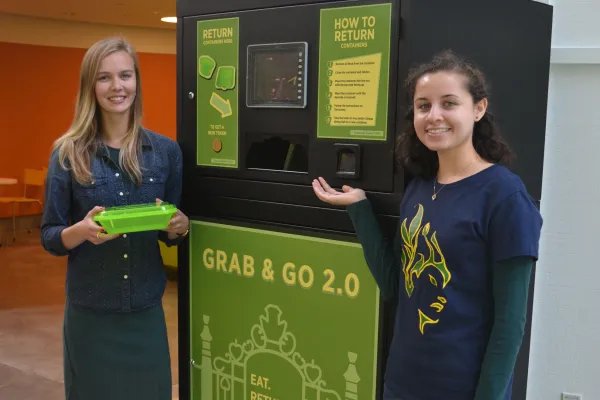A More Sustainable Smith
Sustainability

Published September 20, 2017
Reusable dining ware, more solar panels on college buildings and a new action plan for addressing climate change—these are just some of the ways that Smith is more sustainable this year.
The college has launched efforts to increase the amount of locally grown food served on campus and has won national recognition for its environmentally friendly buildings.
This fall, Smith is poised to make progress on recommendations from President Kathleen McCartney’s Study Group on Climate Change—action steps submitted to the trustees last spring covering curriculum, campus operations and investments, among other aspects of college life.
At Smith, students, faculty and staff are closely involved in sustainability initiatives, says Dano Weisbord, Smith’s director of sustainability.
“We let students practice being change agents by getting their help with all of our institutional sustainability initiatives,” he says. “The college’s challenges provide a great way for students to connect theory to a real organizational context—not unlike the ones they will work in eventually.”
Interested in joining efforts to reduce the college’s carbon footprint? The Office of Campus Sustainability is a hub for information about recycling, composting, sustainable transportation options and other strategies.
Also, be sure to check out the weekly “green events” calendar compiled by Smith’s Center for the Environment, Ecological Design and Sustainability (CEEDS).
Here are some ways that Smith is more sustainable this semester:
Gold rating
Smith earned a gold rating from the Association for the Advancement of Sustainability in Higher Education for the college’s overall “sustainability performance.” The prestigious ranking is based on a host of self-reported measures, including curriculum, research, operations, public engagement and leadership. Among the factors that led to Smith’s gold rating were reduced energy consumption in campus buildings, the formation of a committee on investor responsibility and the growing proportion of faculty members (now at 28 percent) engaged in research on sustainability issues.
More ‘real food’
Since joining the national Real Food Challenge just one year ago, Smith has already met its pledge to make 20 percent of food provided on campus sustainable—doubling the amount of food that meets the stringent locally grown, organic and fair trade standards set by the Real Food organization. “It’s going to be an exciting year!” says Andy Cox, Smith’s director of dining services, as the department works to bring more sustainable food and food practices to campus. Menus and more can be found on Dining Services’ new website.
Grab & Go 2.0
Reusable meal containers for grab-and-go dining are available for the first time this fall. Students will receive a token that can be given to dining hall coordinators in exchange for a container. After each use, containers must be returned to vending machines in the Campus Center, Tyler or Scales in exchange for a token for a freshly washed container for the next meal. “This should save a huge amount of energy we now spend providing compostable plates and bowls,” explains Kaylie Abner ’19, who worked on the rollout of Grab & Go 2.0. “Our slogan for the new system is ‘Eat, Return, Repeat!”
Action on climate change
The final report of Smith’s Study Group on Climate Change is a blueprint for embedding sustainability across all aspects of the college—from classroom education to financial investments. The result of a yearlong study, with input from experts and hundreds of Smith students, faculty and staff, the recommendations focus on how Smith can contribute to climate change solutions—both on campus and off.
Eco-friendly pavement
A student-led experiment to find better ways of managing stormwater on campus has yielded positive results. Since last fall, a 12-car student parking lot on Mandelle Road has been a laboratory for testing the effectiveness of permeable pavement, which allows stormwater to move through and be absorbed into the ground. Results so far show “permeable pavement is a viable option” for reducing runoff and filtering pollutants, says professor Robert Newton, director of CEEDS. Stay tuned for more progress on the project from Smithies in a fall special studies course.
Tree planting
Smith’s MacLeish Field Station in Whateley is home to experiments aimed at restoring American chestnut tree hybrids to southern New England. The 3,000 trees now growing in the field station orchard are being evaluated for their ability to withstand blight, in hopes of producing blight-resistant nuts. A video of the planting of the 3,000th chestnut tree is available online.
Going solar
Smith’s Center for Early Childhood at Fort Hill will soon become the seventh college-owned building to install rooftop solar panels. Others are: the Campus Center, the Indoor Track and Tennis Facility, Ford Hall, McConnell Hall, 67 West Street and the Bechtel Environmental Classroom at MacLeish. About 2 percent of Smith’s total electricity is now generated by solar power—enough clean energy to power 44 average homes. Find out more via the new dashboard display in the Campus Center, which provides real-time data on solar power at the center.
Breanna Parker '18 (left) and Alexandra Davis '18 try out one of the college's new vending machines for reusable grab-and-go dining containers.